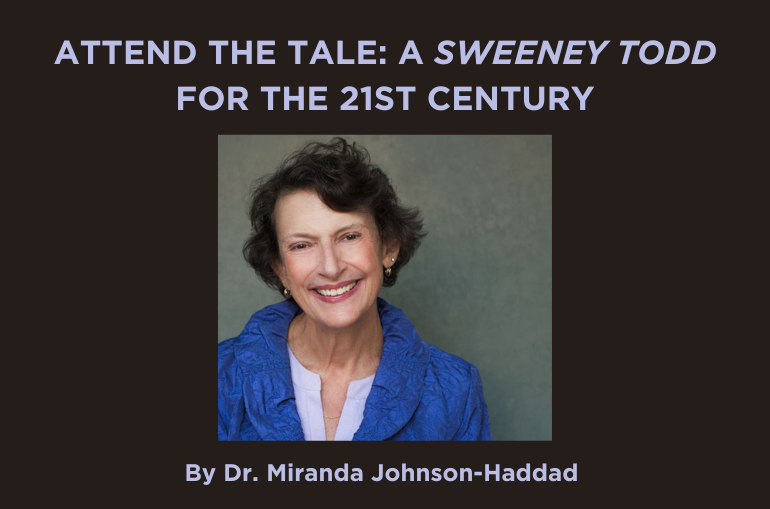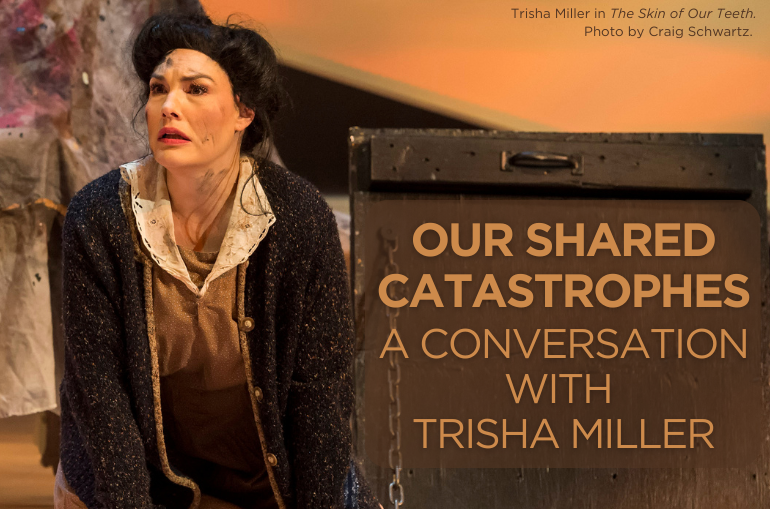ATTEND THE TALE: A SWEENEY TODD FOR THE 21ST CENTURY

By A Noise Within
January 18, 2024
By Dr. Miranda Johnson-Haddad (Resident Dramaturg, A Noise Within)
Ever since its debut on Broadway in 1979, Stephen Sondheim’s musical Sweeney Todd has usually been described as a “dark comedy,” a “comic-horror musical,” or with such epithets as “hilariously terrifying.” (“Murder most tasty!” jokes one reviewer of the current Broadway revival.) But as entertaining and even moving as these productions have often been, Sweeney Todd, which many people regard as Sondheim’s finest work, is now forty-five years old, and it speaks to us differently now, in the twenty-first century, than it did before. Certainly the question of “who gets eaten and who gets to eat” feels even more urgent today, as the answer to that question becomes increasingly ruthless. But are there additional ways in which contemporary concerns and awareness might enhance our understanding of Sweeney Todd and allow for a deeper and more nuanced appreciation of Sondheim’s masterpiece?
The themes of Sweeney Todd – including social justice, moral corruption, psychological obsession, and trauma cycles – remain highly relevant today, and many of us now bring a more empathic understanding to these topics, which is a positive development. Less encouraging, however, is the fact that too often the prejudices and judgments that the Victorians of Sweeney Todd’s world inflicted upon their less fortunate fellow citizens endure in contemporary attitudes as well. In Victorian England, and in the U.S. today, attitudes towards the poor and especially towards the unhoused – a community in which the incidence of mental illness was and remains high – are depressingly similar.
As Director Julia Rodriguez-Elliott has observed, most of the central characters in Sweeney Todd appear to be suffering from some form of mental illness, which in today’s world we would understand as resulting from trauma. For the upcoming production at A Noise Within, Rodriguez-Elliott will focus not only on the characters’ often troubled psyches, but on the complex intersection of mental illness and homelessness as well. Every element of the show, from sets to costumes to musical arrangements, is designed with these concerns in mind, resulting in a very different Sweeney Todd from the typical productions of the last four decades.

No character in Sweeney Todd embodies the experience of trauma and the consequent mental breakdown more than Sweeney Todd himself. Sweeney returns to London deeply embittered and grief-stricken, though his grief speedily devolves into an obsessively brutal desire for revenge. Although not a war veteran, Sweeney nevertheless returns to London transformed in ways that are reminiscent of the Post Traumatic Stress Disorder (PTSD) that many combat veterans suffer. Furthermore, Sweeney’s ordeal actually does echo one of the most psychologically traumatizing events that some war survivors experience: the sense of having been betrayed by the forces of “rightness” that supposedly ensure the safety and protection of all citizens. Sweeney has been victimized by the very forces of law (Judge Turpin) and order (Beadle Bamford) that are intended to keep society functioning as it should. Sweeney’s deep sense of betrayal, combined with the trauma caused by fifteen harsh years spent as a convict in Australia, render him a completely different person from the former Benjamin Barker. Sweeney’s fury and his obsession cross over into insanity in “Epiphany,” for during this song Sweeney speedily descends into the type of full-blown psychopathology that characterizes a serial killer – which, of course, he then becomes.
Other characters in the musical also appear to be suffering the effects of trauma. The Beggar Woman shows clear signs of what today we might identify as a combination of complex PTSD and Dissociative Identity Disorder (evidenced by her swift alterations back and forth between a confused, almost sweet, “pitiful woman what’s got wanderin’ wits” and the hypersexualized, coarse individual who makes aggressively bawdy overtures to Anthony and Sweeney). The additional trauma caused by living on the streets, as the Beggar Woman has evidently been doing for some time, contributes to her deteriorating mental condition.
Even Johanna seems more than a little unhinged in her instantaneous love for Anthony and her willingness to entrust herself to a total stranger. Though Johanna is often played as a classic ingenue, gentle and innocent, her actions arguably reveal her frantic desperation to escape the strict confines of her existence. As many psychologists have noted, captivity – and especially long-term captivity, such as Johanna endures — is considered one of the most difficult and traumatic events that a person can undergo. But with or without a label for Johanna’s psychological state, we may reasonably conclude that telling someone that “I knew I’d be with you one day, / Even not knowing who you were” (as Johanna sings to Anthony in “Kiss Me”) reads more plausibly as extremely desperate, rather than as charmingly romantic.
Finally, several other characters exhibit behavior that, while perhaps not diagnosable, certainly isn’t normal. Mrs. Lovett may not meet the formal criteria for a psychopath, but her moral compass is at best extremely weak (and her culinary practices are highly unorthodox, to say the least). Judge Turpin obviously possesses a severely twisted psyche, though ultimately he seems wicked rather than diagnosable. In this regard, Judge Turpin is closer to some of the other characters, notably the corrupt Beadle Bamford and the con artist Pirelli, who represent those members of society who choose to enable and engage in evil, whether grand or petty, and in doing so further degrade the moral fabric of the community.
Bringing newer understandings about mental illness and trauma to bear upon these characters allows us to better understand the complex social challenges that confronted people in Victorian England and that continue to do so in our own time. Huge numbers of the Victorian populace were unhoused, or in danger of becoming so at any time, especially in London. Similarly, in the U.S. today, on any given night in 2023, more than 653,000 people nationally experienced homelessness, according to the National Alliance to End Homelessness. This organization notes that California’s total unhoused population increased by 23% between 2007 and 2022. In Victorian England, as in the U.S. in 2024, many of the unhoused suffered from mental illness; and then as now, many of the unhoused also struggled with addiction (gin was the scourge of the eighteenth and nineteenth centuries in England).
Addiction complicates homelessness in a multitude of ways and affects social attitudes towards these struggling individuals. Many of those who blame the poor and the unhoused for their situation (in Victorian England and in 2024 America) focus on the problem of addiction. Outmoded understandings of addiction as resulting from a “lack of willpower” (rather than more recent perceptions of addiction as a disease and a means of self-medicating for untreated mental illness) often underlie contemporary lack of empathy towards the sufferers. Indeed, the more we learn about Victorian attitudes towards the unhoused and the mentally ill, the more depressingly familiar those attitudes become. The complaints one reads on the Next Door app about the presence of the homeless and the mentally ill on our streets echo those expressed by the more fortunate members of Victorian society towards the sufferers of that time. Ignorance about trauma, and about mental illness, can lead to a profound lack of compassion and even to blaming the poor for their poverty – viewpoints that all too often characterize both the Victorian era and our own.
In 2005, the BBC aired a different version of the Sweeney Todd story: a play that reimagined the tale by setting it a century earlier. British actor Ray Winstone, who played Sweeney, observed in an interview that “Sweeney is London. He’s this man whose very life becomes a response to the inhumanity of the city.” As we reflect upon Sweeney Todd’s themes of betrayal and trauma, of moral corruption, and of an obsessive desire for vengeance, we may begin, uncomfortably, to recognize the similarities between the cruelty of Sweeney’s London and our own cold-hearted indifference to the suffering of our fellow human creatures. No one is immune from traumatic experiences, or from mental illness; and perhaps, once we recognize and embrace this common truth, we will care enough to take the necessary steps to stop perpetuating the endless cycles of trauma that ultimately lead only to more fear and more cruelty, and that keep us trapped – as individuals and as a society — in ever-worsening violence. Otherwise, if we continue to remain indifferent to these human conditions, we risk becoming like Sweeney, “Hugging the blade, waiting the years, / Hearing the music that nobody hears.” Sweeney Todd’s narrative may be dramatically powerful, but in the end, we would all do well to “attend the tale,” because his story is a deeply tragic one that no amount of humor, dark or otherwise, can altogether dispel.








